
2015

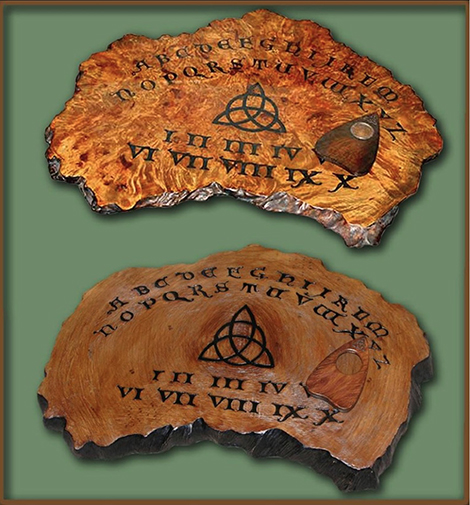
The Charmed Cow Pie? Fans of the TV show Charmed may remember the Halliwell's spirit board from seasons one and two. The burled wood beauty created by Sword and Stone's Tony Stratton was a standout and the first time a talking board was cast as a recurring actor in any TV series. After months of sales hype, Sota Toys released their "exact replica" in 2006 shortly after the show ended. Why so long you ask? Produced overseas, the replica was plagued with manufacturing problems and missed deadlines. The finished product was not "exact'' by any stretch of the imagination as you can see by the lower picture but was instead a thick, weighty monster made from cast resin. Coloring varied from board to board and many agreed: it was an ugly mess, prompting the nickname, the Charmed Cow Pie. And a stinker it was. The planchette, made from the same heavy resin, refused to slide on the board. Presentation boxes rarely survived shipping without crushed corners because of the weight. Nevertheless, even at the stiff $249 store price, fans and collectors snapped them up proving, I suppose, that it is charmed to be Charmed. - December 29, 2015

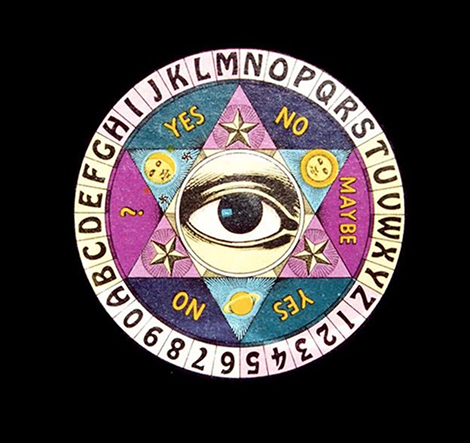
If you have any interest in talking boards you've no doubt spotted the iconic image above. There is something about it that captures the imagination. Maybe it's the eye: staring, unblinking, that draws you in. Perhaps it's the overall imagery with the lack of factory branding or association that conveys an air of mystery not found on conventional talking boards. Looking closely, it makes you want to touch it, use it, experiment with it. Or not? YES? NO? MAYBE? Since it first appeared on the World Wide Web in the mid 1990s we've seen this image everywhere. It's been the darling of Internet artists who have transformed it into everything from pendants to earrings to jewelry boxes to countless other things. It's been in magazines and on book covers. People use it in their personal blogs.
Maybe you're mildly curious. Maybe you're asking: where did it come from? Well, lucky for you. It's the job of talking board historians to know these things. Welcome to the Finger of Fate, first released in 1971 by Colorforms as an odd little fortune-telling game. Part talking board, part crystal ball, it's the brainchild of one Melvyn Birnkrant from Beacon, New York who describes it in his patent as an "answer board with magnetically influenced pointer." It's also almost impossible to use prompting some to rename it "the Middle Finger of Fate." A magnetic pointer hangs weirdly in the center of a small plastic globe. Tilting the globe from side to side allows the pointer to twitch spasmodically over the letters letting "the Finger of Fate swing your way." It may be the worst working talking board of all time because it's soon apparent that not a single thing swings your way. Photographing the letter and number image in the bottom requires prying apart the globe and destroying it if you are not extremely careful. But it's not much of a loss and as a result, a picture destined for obscurity has a new life, purpose, and audience. Melvyn Birnkrant, wherever he might be, would be proud. -December 23, 2015

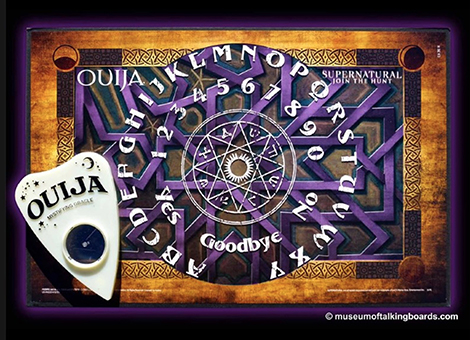
How many letters in the alphabet again? Oh, yes — that's 26. But look not so closely and you'll see only 25 on this Supernatural Join The Hunt Ouija Board from USAopoly. So what happed to the Z? Should we be hunting for it? Is this a dark conspiracy that we all should be talking about? Maybe. Maybe not. One concerned citizen reported back with this tidbit from USAopoly:
"Thank you for contacting USAopoly. Good Question! However, it is not a mistake, When we make a game, the Licensor provides all artwork and approves all design. We used the artwork that the Licensor provided. And they approved the final product. (Whether they meant to omit the "Z" intentionally or an oversight, we'll never know)."
The "licensor" in this case was Hasbro and their design team. One is left to wonder if it was just late in the day when they approved this board or if what another reviewer on Amazon reported was the real answer:
"For those of you complaining about the lack of the letter Z, it's intentional. This is a safe Ouija board. "Z" is considered evil and bad. There is an alleged demon who goes by the name of "Z" or "Zeze" or "Zozo" and etc. who is a dark entity. Without the access to the letter Z on the board, this entity cannot contact you. The design purposefully leaves out the letter Z to KEEP YOU SAFE." -December 16, 2015

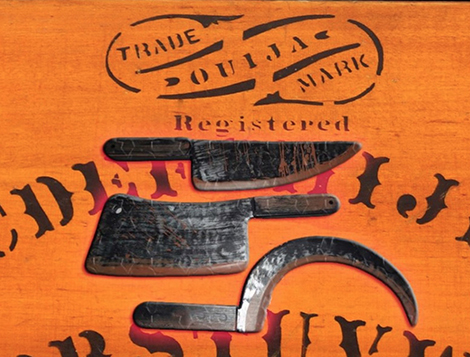
Sometimes its fun to revisit Ouija horror stories of the past to see how they reflect the period. Are they the same as what we see today or different? Maybe it's most accurate to say that actually they are the same, only different. Two Liberty residents, a Mr. John Chapman and his wife became "over excited" while participating in neighborhood Ouija demonstrations according to 1892 Indiana newspaper reports. Panicked, they locked the children in their rooms and destroyed nearly all the furniture in the house. Concerned police found Mrs. Chapman (a minister's daughter) cutting circles on the walls of her room. Mr. Chapman was doing the same with a scythe. Carpets in the home had all been slashed into small strips and knives, hatchets and other "deadly weapons" were found lying about. Mrs. Chapman explained that Horace Greeley had contacted her during a Ouija session and commanded her to convert the world to Masonic principles. It was unclear how their actions were going to accomplish this. -December 9, 2015

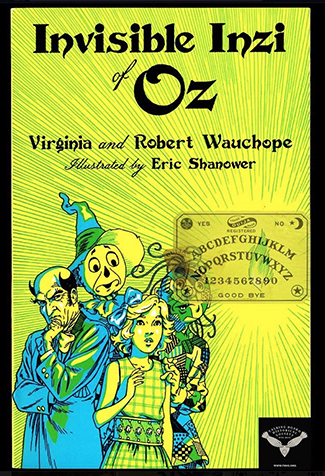
Headed for the Emerald City? Maybe there is more to fear than winged monkeys and the Wicked Witch of the West. Oz fans know that there were 14 original Oz books plus many by other writers. The Wauchope children, Robert (9) and Virginia (13), wrote an Oz book, edited by their mother, under direction of a Ouija board. The year was 1920 and L. Frank Baum, the series original creator, was dead less than a year. Could this book have been his final literary effort from beyond the grave? Most Oz lovers doubt it. They agree that Invisible lnzi of Oz is not the best of the Oz books and that is putting it charitably. Some think that it may well be the worst. -December 2, 2015

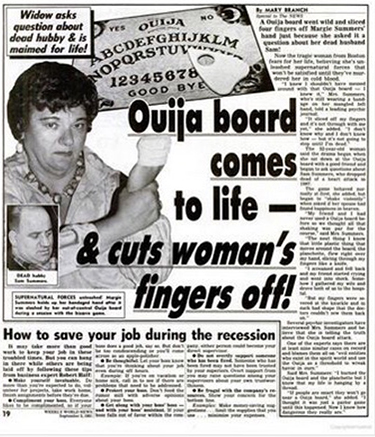
In 1991, the World Weekly News reported a horrible accident that occurred when Bostonian Margie Summers asked a question about her dead husband. "The next thing I know that little plastic thing that moves around the board, the planchette, flew right over my hand slicing into my fingers like a knife. I screamed and fell back and my friend started crying and went into shock. Somehow I gathered my wits and drove both of us to the hospital" she said. Perhaps more informative than the Ouija story was the one below it titled "How to save your job during the recession." It had this insightful suggestion: "Complement your boss and don't feed the rumor mill with adverse opinions about him." -November 24, 2015

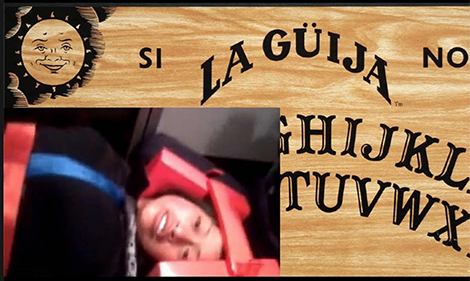
All too often, everything about a Ouija story is wrong. The June 23, 2014 headlines read "Three American friends hospitalized after becoming 'possessed' following a Ouija board game in Mexican village" and a video of girl, restrained on a stretcher growling and convulsing reminiscent of The Exorcist's Regan MacNeil quickly went viral. Subsequent investigation revealed what had really happened. The Mexican teens were encouraged by an adult guardian to take the psychedelic drug Brugmansia to "help contact" the spirit world before a Ouija session. Brugmansia causes a person to fall into a psychotic state and is deadly in large doses. Nevertheless, the guardian insisted: "She was possessed by a spirit who wanted to harm her." -November 17, 2015

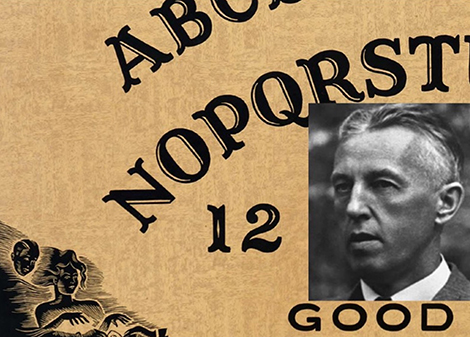
In recovery? Who isn't these days. It may interest you to know that Bill Wilson, co-founder of Alcoholics Anonymous, wrote his book Twelve Steps and Twelve Traditions (1953) while communicating with a 15th Century monk through a Ouija board. This apparently caused consternation among some of his AA members. Perhaps it stemmed from the rumors that Wilson and his wife had a specially designed "spook room" in their house where they invited visitors to participate in group seances. Consternation or not, today's AA members number in the millions internationally. -November 10, 2015

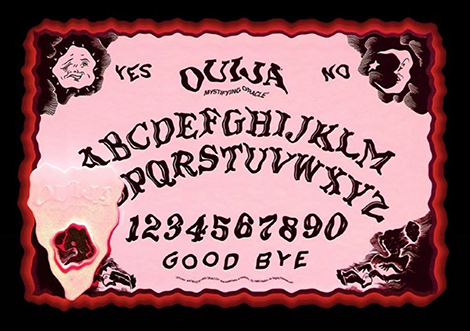
How scared are you of your Ouija board? Scared enough to be rid of it by any means possible? But how to do that? Burn it? Sprinkle it with holy water then break into seven pieces and bury it? The Ouija is terrifying to some of you and we know that because you send us the emails. You are horrified that you've opened a door you can't close — that your bad luck is directly caused by that session that you knew was a bad idea but performed anyway. And now your life is in the worst form of jeopardy. They are coming for you and you are desperate to do anything to save yourself. Eek! You are surely doomed. You must be rid of your Ouija boardl So, really. How scared are you? An informal survey by the Museum of Talking Boards, which takes donations of troublesome Ouija boards, reports that approximately only one in fifty actually arrives. The reason? The shipping costs. Yes, you read that right. The cost of postage, which varies from $7 to $10, is enough to dissuade even the most terrified lost soul. Well, forty-nine out of fifty of you, anyway. -November 2, 2015

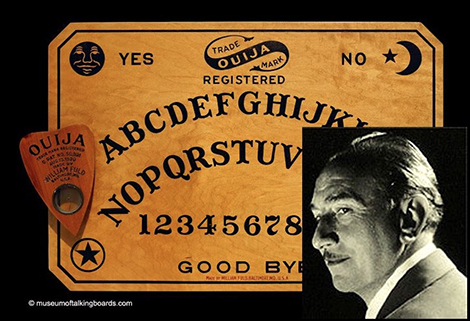
Having difficulty putting your tunes together? Composer and musical genius Rudolf Friml used the Ouija board regularly as inspiration to compose his operettas in the 1930s. "I really don't want to take it too seriously" He said, "but it is decidedly interesting. I talk to Chopin in French and Victor Herbert. Why Herbert once gave me five notes and I played it on the piano and everyone said it was Victor Herbert." When it came to world affairs, Friml also got the inside scoop: "I get big people like President Wilson. I got Napoleon the other day. I was told Germany was going to be destroyed. He told me in French. I knew the war would start on September 2, and it did." -October 22, 2015

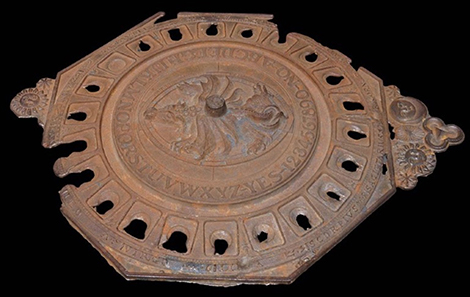
One look at this ten pound cast iron talking board from a bygone era and you will be wondering: where did it come from? How did it work? Who made it? How ancient could it possibly be? You may be thinking that there is a weird story here and we can guarantee that there is. Check back tomorrow for the full explanation and learn how even knowledgeable peopie can be fooled. -July 8, 2015

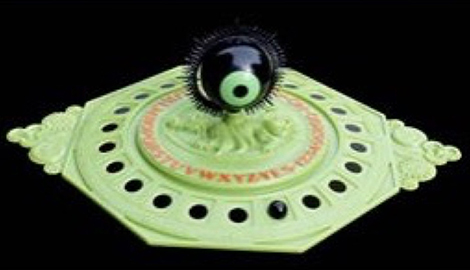
Seen in a different context, the origin of this "ancient" talking board becomes immediately clear. It is a cast iron version of Transogram's 1967 game ka-bala and either is a factory template or a casting by a clever experimenter. The game is played like this: you and a partner are instructed to start the game with the chant: "PAX, SAX, SARAX, HOLA, NOA., NOSTRA." From this point on, anything can happen as the two of you, with your hands on the "Solary Projectors," roll a black marble around the channel that circles the board and wait for it to come to rest at one of the many symbols. Depending on the "Astral Plane" chosen, the future is revealed by letters and numbers like a talking board, or by Tarot cards placed in specially designed "wells," or astrologically by the zodiac conveniently spelled out in bas-relief around the perimeter of the board. The cast iron template came to us by way of an expert in antiquities who was convinced that it was of ancient origin and worth a fortune. Imagine his embarrassment. -July 9, 2015

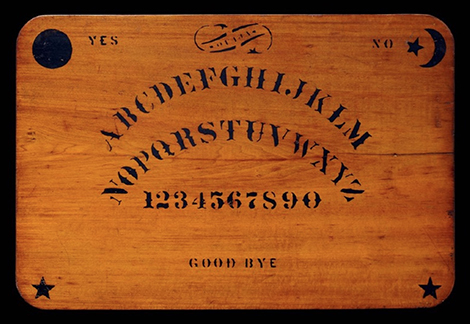
Might this be one of the very first ever production Ouija boards? The lack of the front "Trade Mark" and "Registered" and absence of an 1891 patent stamp, plus very thick 1/2 inch construction with oddly routered edge, seems to indicate that it is. Talking board historians pore over minute details like these to determine age. Sometimes we are right and sometimes, not so much. The process is ongoing with new discoveries coming forth regularly. Knowing what we do, we date this board as an early 1890 Kennard Novelty Ouija. -June 30, 2015

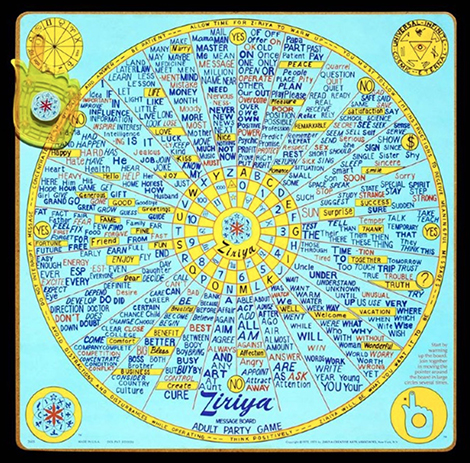
Yikes! If you are wondering what kind of talking board this might be, you are not alone. The big problem for beginners when trying the Ouija, is to get the darn thing to work. Let's face it; sometimes you sit there for a very long time with nothing much happening. The Ziriya's "Word-salad" approach attempts to alleviate this by offering you words to form sentences instead of individual letters. But does it work? Yes, it does and quite well, thank you. First offered in 1972 as the Human Battery Circuit by Ziriya Creative Arts founders, Ziva Rosen and Jacob Burke, it became Ziriya, the Adult Party Game when distributed by game maker ES Lowe/Milton Bradley in 1975. The box was clearly marked "10 to Adult" making it not quite so adult but then what do we know. Nonetheless, the Ziriya, with enough words to lead you in almost any direction, is worth a hard look or anyone seriously interested in this form of communication. Remember: "Ziriya will be what you want it to be." Explore eBay and second hand stores near you. -February 5, 2015

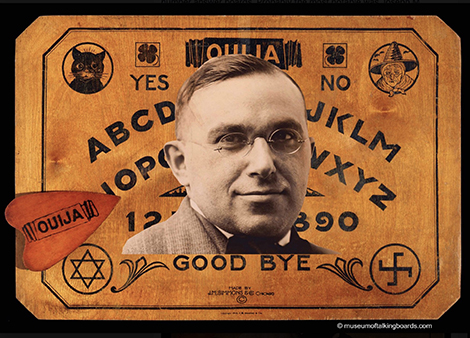
Young people these days associate the name Hasbro with the Ouija board. Gone since 1999 is the name William Fuld who produced the novelty for so many years and was considered by many to be the father of the Ouija board due to his company's prolific output. But there were other manufacturers who used the Ouija name on similar letter and number answer boards. Probably the most notable was Joseph M. Simmons, Chicago entrepreneur, maker, and general badass, who earned the moniker "The Ouija King." J.M. Simmons was in it strictly for the money and he let people know it:
"The public are fools! They'll bite on anything. The public belief in the Ouija board is a joke. We don t foster it. But the poor deluded fools want the board and we're giving it to them by the thousands."
A scrapper, Simmons audaciously sued William Fuld for $50,000 saying that Fuld's publicized claim to "the original Ouija Board" was erroneous and damaging to his business. For decades, Simmons manufactured millions of Ouija boards recognizable by the placement of the Star of David on one side and the swastika on the other. The swastika was a good luck symbol used on many fortune telling games at the time. Sometime in the early 1940s, Simmons prudently changed the swastika to a horseshoe and printed in big letters on the back of his boards "Made in USA." His boards are plentiful today and often show up for sale on eBay. -January 30, 2015

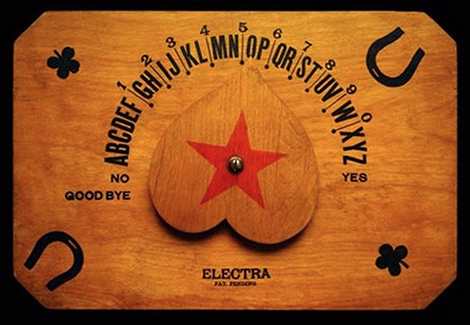
Known as dial plates, dial planchettes, or psychographs, these odd talking boards with their fixed revolving planchettes first appeared as early as the 1850s predating the Ouija board by a considerable margin. The operation is similar to a conventional talking board. Sitters place their fingers upon the pointer and it revolves around a central axis to spell out messages. One advantage to this type of board is that the pointer or planchette cannot slide off the board and that, according to some makers, makes communication more precise and easier to interpret. The Electra pictured here is a particularly nice instrument made by the George H. Leonard Company in 1921. Ball bearings under the pointer make for an exceptionally smooth movement. -December 5, 2014.
Ouija-stitions | Interactive | Books | Movies | Collect | Buy | Links | e-mail
You are visiting the Museum of Talking Boards
Copyright © All Rights Reserved.